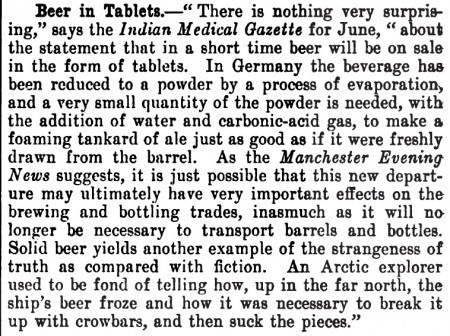Marc Abrahams's Blog, page 410
April 20, 2014
They trained chickens to play baseball, and then some
Psychologist B.F. Skinner’s operant conditioning work inspired the work of Marian Breland Bailey. Bailey’s work inspired this study:
“Marian Breland Bailey: The Mouse Who Reinforced,” John N. Marr, Arkansas Historical Quarterly. Vol. 61, No. 1 (Spring, 2002), pp. 59-79. Marr writes:
Marian and her first husband, Keller Breland, had become the most experienced and accomplished mammal, fish, reptile, and bird trainers in the world, and they did most of their work in Hot Springs, Arkansas. They were the first scientists to see that the methods used in that original pigeon project of World War II could be employed to train animals to do almost anything within the creature’s repertoire to work for and to entertain humans…
Other rooms contained chickens walking the “circus high wire” or pecking a button that caused a miniature baseball bat to hit a ball into the left field fence as the chicken ran the bases for a home run. Ducks played drums or pecked at the keys of a piano. Squirrels raised a flag up a pole to the sound of a bugle. Rabbits rode on the back of a miniature fire truck when the fire alarm rang or kissed a bunny doll until it “lit up.” Raccoons had to stuff a ball through a basket before a food light would blink. The baseball-playing chicken exhibit was also displayed in the window of a large department store in New York. The chicken’s performance was not in the least affected by the cheering of a large crowd on the sidewalk when she “hit” a home run; she would even trot back to home plate to try again when the ball was “caught” or hit foul (signified by the failure of a small light at first base to light up).
(Thanks to investigator Mason Porter for bringing this to our attention.)
BONUS (not necessarily not related): Chicken, Chicken, Chicken

April 19, 2014
“This is quite possibly the worst paper I’ve read all year”
“This is quite possibly the worst paper I’ve read all year,” writes Lior Pachter in his blog, Bits of DNA, proceeding to perform a detailed, methodical autopsy. He’s talking about this paper, which has been the subject of many scare-inducing news reports (with scare-inducing headlines like this one: “Even Casual Marijuana Use Causes Brain Abnormalities“):
J.M. Gilman et al., Cannabis Use Is Quantitatively Associated with Nucleus Accumbens and Amygdala Abnormalities in Young Adult Recreational Users, Neurobiology of Disease, 34 (2014), 5529–5538.
Professor Pachter, after dissecting the study, ends his essay with a tidy thought:
…I believe that scientists should be sanctioned for making public statements that directly contradict the content of their papers, as appears to be the case here. There is precedent for this.
(Thanks to investigator Ivan Oransky for bringing this to our attention.)
Here are:
The official press release about the study.
 The study’s authors, and the institutions with which they are affiliated (as listed in the study): Jodi M. Gilman1,4,5, John K. Kuster1,2,*, Sang Lee1,6,*, Myung Joo Lee1,6,*, Byoung Woo Kim1,6, Nikos Makris3,5, Andre van der Kouwe4,5, Anne J. Blood1,2,4,5,†, and Hans C. Breiter [pictured here]1,2,4,6,†
The study’s authors, and the institutions with which they are affiliated (as listed in the study): Jodi M. Gilman1,4,5, John K. Kuster1,2,*, Sang Lee1,6,*, Myung Joo Lee1,6,*, Byoung Woo Kim1,6, Nikos Makris3,5, Andre van der Kouwe4,5, Anne J. Blood1,2,4,5,†, and Hans C. Breiter [pictured here]1,2,4,6,†Those institutions (as listed in the study): 1 Laboratory of Neuroimaging and Genetics, Department of Psychiatry, 2 Mood and Motor Control Laboratory, 3 Center for Morphometric Analysis, Department of Psychiatry, and 4 Athinoula A. Martinos Center in Biomedical Imaging, Department of Radiology, Massachusetts General Hospital, Charlestown, Massachusetts 02129, 5 Harvard Medical School, Boston, Massachusetts 02115, and 6 Warren Wright Adolescent Center, Department of Psychiatry and Behavioral Sciences, Northwestern University Feinberg School of Medicine, Chicago, Illinois 06011
Here, also as listed in the study, are the “author contributions” to the study:
J.M.G., M.J.L., B.K., N.M., A.J.v.d.K., A.B., and H.C.B. designed research; J.M.G., J.K.K., S.L., and A.J.v.d.K. performed research; M.J.L., B.K., A.B., and H.C.B. contributed unpublished reagents/analytic tools; J.M.G., J.K.K., S.L., M.J.L., N.M., A.B., and H.C.B. analyzed data; J.M.G., A.B., and H.C.B. wrote the paper.
*J.K.K., S.L., and M.J.L. contributed equally to this work.
†A.J.B. and H.C.B. contributed equally to this work.
BONUS: Description of a talk by Dr. Breiter1,2,4,6,† (the anchor editor of the cannabis study), with a modestly extensive biography of Dr. Breiter, highlighting a few of Dr. Breiter’s many accomplishments.

The tomatoic under-arm odour of J.C.M. Stewart
J.C.M. Stewart conveys an unusual kind of information in this medical paper:
“Tomatoes cause under-arm odour,” J.C.M. Stewart, Medical Hypotheses, vol. 82 (2014) pp. 518–521. (Thanks to Jean-François Sauvé for bringing this to our attention.) The author, in Downpatrick, Co Down, Northern Ireland, explains:
“I was more than usually aware of my AO [armpit odor] one hot summer seven years ago when colleagues became restless and routinely opened windows in my presence. Nothing was ever said of course but this happened so regularly that there was no doubt about it, I eventually realised: I was the centre of a perfect pong. This is embarrassing and totally unacceptable to anyone working in a professional capacity. Yet a scrupulously cleansing shower each morning did not eliminate the problem. It happened I did not use deodorants or anti antiperspirants so the AO was not artificially suppressed.”

April 18, 2014
Virtual hand shadow theatrics
If you, like Raymond Crowe shown above, are a professional hand-shadow artist (viz. a shadowgrapher according to Wikpedia) then you might think that your job is one of the relatively few that is unlikely to be replicated by a computer any time soon. Think again. Work underway at the IMAGINE (Intuitive Modeling and Animation for Interactive Graphics & Narrative Environments) Laboratory, Grenoble, France, is attempting just that. Here, they announce an M.Sc. / Ph.D. internship opportunity :
“The goal of the internship will be to design and implement generative methods for automatically animating virtual hands and generating shadow plays driven by objective goals, such as reproducing a given shape or motion; or visualizing a given story.”
BONUS Shadowgraph of an exploding balloon filled with hydrogen/air (is there a mystery face at around 11 seconds, or is it an illusion?)

April 17, 2014
The drop dropped in the Ig Nobel-winning pitch drop experiment
Big little news from Queensland, as reported by Celeste Biever and Lisa Grossman for New Scientist magazine:
Longest experiment sees pitch drop after 84-year wait
The pitch has dropped – again. This time, the glimpse of a falling blob of tar, also called pitch, represents the first result for the world’s longest-running experiment…. Up-and-running since 1930, the experiment is based at the University of Queensland in Australia and seeks to capture blobs of pitch as they drip down, agonisingly slowly, from their parent bulk.
The Queensland experiment already features in the Guinness World Records and won an IgNobel prize in 2005. It was set up by physicist Thomas Parnell to illustrate that although pitch appears solid, shattering when hit with a hammer at room temperature, it is actually a very viscous liquid.
The eventual result follows several near misses, according to the University of Queensland. John Mainstone, who oversaw the experiment for more than 50 years until his death last August, missed observing the drops fall three times – by a day in 1977, by just five minutes in 1988 and, perhaps most annoying, in 2000, when the webcam that was recording it was hit by a 20-minute power outage….
The university issued an official announcement of the drop’s dropping. The experiment was begun by “the University of Queensland’s first physics professor, Thomas Parnell, in 1927.”
Three decades later, more or less, Professor John Mainstone took over from Professor Parnell. Professor Mainstone oversaw the experiment at the time the Ig Nobel Prize was awarded, and attended the ceremony at Harvard. Alas, he did not live to see the ninth drop drop.
Professor Andrew White, youthful, now oversees the experiment.
BONUS: The live webcam view of the experiment, which now is hurtling at extremely low speed towards the day or night when the tenth drop will drop.

The curses of being a rat: Landmine-detection reinforcement
Bit by bit, people work to devise improvements in procedures related to explosions. This study tells of one such effort:
“Landmine-detection rats: An evaluation of reinforcement procedures under simulated operational conditions,” Amanda Mahoney, Kate Lalonde, Timothy Edwards, Christophe Cox, Bart Weetjens and Alan Poling [pictured here], Journal of the Experimental Analysis of Behavior, epub March 27, 2014. The authors, at APOPO in Santa Clara, California, and Western Michigan University, explain:
“The results of this translational research study suggest that the TNT-contamination procedure is a viable option for arranging reinforcement opportunities for rats engaged in actual landmine-detection activities and the viability of this procedure is currently being evaluated on minefields in Angola and Mozambique.”

Instant beer: The birth of a notion
Along with jetpacks and hose-down-able houses, food in pill form has been perennially one of those futuristic advances that is just around the corner. 65 years before Willy Wonka’s three-course-meal chewing gum, German scientists brought us desiccated beer — according to the Indian Medical Gazette, summarized here in the New York Medical Journal [July 22, 1899 -- p. 143].
No doubt this was technically possible in some form, but it was desired by nobody, not even arctic explorers.
In Germany the beverage has been reduced to a powder by a process of evaporation, and a very small quantity of the powder is needed, with the addition of water and carbonic-acid gas, to make a foaming tankard of ale just as good as if it were freshly drawn from the barrel.
Now in 2014, the dream lives on. Insta-Beer, “the world’s first instant beer”, is available exclusively at KegWorks. And who is responsible? A “dedicated team of German scientists”.
Follow Amboceptor on Twitter: @AmboceptorBlog

High-level food for fad-diet theorists
Persons who make their living by creating, naming, and giving advice about fad diets can find food for their professed thoughts about food in this new study:
“Lower Obesity Rate during Residence at High Altitude among a Military Population with Frequent Migration: A Quasi Experimental Model for Investigating Spatial Causation,” Jameson D. Voss, David B. Allison, Bryant J. Webber, Jean L. Otto, Leslie L. Clark, PLoS ONE, April 16, 2014DOI: 10.1371/journal.pone.0093493. The authors explain:
“Whether or not high altitude residence confers benefit in humans… remains unknown.”
The study contains the intellectually inspirational statement:
“Among overweight service members in the U.S. Army and Air Force between January 2006 and December 2012, those stationed at higher altitude duty locations had a lower incidence of obesity.”
BONUS INFO: The co-authors, all of whom now have proper credentials to create new diet books and televised lectures, are dispersed among the following institutions: 1Epidemiology Consult Division, US Air Force School of Aerospace Medicine, Wright Patterson Air Force Base, Ohio, United States of America, 2Department of Preventive Medicine, Uniformed Services University, Bethesda, Maryland, United States of America, 3Department of Biostatistics, University of Alabama at Birmingham, Birmingham, Alabama, United States of America, 4Nutrition and Obesity Research Center, University of Alabama at Birmingham, Birmingham, Alabama, United States of America, 5Trainee Health Surveillance, Joint Base San Antonio – Lackland, Lackland, Texas, United States of America, 6Armed Forces Health Surveillance Center, Silver Spring, Maryland, United States of America, 7Henry M. Jackson Foundation for the Advancement of Military Medicine, Bethesda, Maryland, United States of America, 8General Dynamics Information Technology, Fairfax, Virginia, United States of America.

April 16, 2014
Wee mathematics in Portland, Oregon
Today’s mathematics exercise: What, approximately, is the percentage of human wee in the water supply, both before and after the wee was added to the reservoir?
PORTLAND PLANS RESERVOIR FLUSH AFTER TEEN CITED
PORTLAND, Ore. (AP) — …. Portland officials said Wednesday they are flushing away millions of gallons of treated water for the second time in less than three years because someone urinated into a city reservoir.
In June 2011, the city drained a 7.5 million-gallon reservoir at Mount Tabor in southeast Portland. This time, 38 million gallons from a different reservoir at the same location will be discarded after a 19-year-old was videotaped in the act. ”The basic commandment of the Water Bureau is to provide clean, cold and constant water to its customers,” bureau administrator David Shaff said Wednesday….
The urine poses little risk — animals routinely deposit waste without creating a public health crisis — but Shaff said he doesn’t want to serve water that was deliberately tainted.
BONUS CALCULATION: Calculate the percentage of human wee in a standard (any standard) size swimming pool, both before and after one person’s wee was added to the pool.
BONUS CALCULATION: Calculate, approximately, the cost in dollars of administrator Shaff’s precautionary effort.
BONUS: Reports from Oregon Live, and from the Water Bureau.
BONUS: Wee mathematics in Texas (thanks to investigator Tom Gill for bringing this to our attention.)

Winter/Summer Suggestion that Contagious Yawners are Cooling Their Brains
Another attempt to explain the mystery of why people yawn:
“A thermal window for yawning in humans: Yawning as a brain cooling mechanism,” Jorg J.M. Massen [pictured here], Kim Dusch, Omar Tonsi Eldakar, Andrew C. Gallup, Physiology & Behavior, epub 2014. (Thanks to @ThatNeilMartin for bringing this to our attention.) The authors, at the University of Vienna, Vienna, Austria, Nova Southeastern University, Ft. Lauderdale, USA and SUNY College at Oneonta, USA explain:
“The thermoregulatory theory of yawning posits that yawns function to cool the brain in part due to counter-current heat exchange with the deep inhalation of ambient air. Consequently, yawning should be constrained to an optimal thermal zone or range of temperature, i.e., a thermal window, in which we should expect a lower frequency at extreme temperatures. Previous research shows that yawn frequency diminishes as ambient temperatures rise and approach body temperature, but a lower bound to the thermal window has not been demonstrated. To test this, a total of 120 pedestrians were sampled for susceptibly to self-reported yawn contagion during distinct temperature ranges and seasons (winter: 1.4 °C, n = 60; summer: 19.4 °C, n = 60). As predicted, the proportion of pedestrians reporting yawning was significantly lower during winter than in summer.”
Here’s detail from the study:

Marc Abrahams's Blog
- Marc Abrahams's profile
- 14 followers







